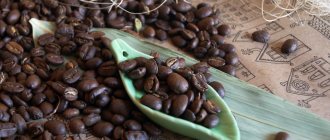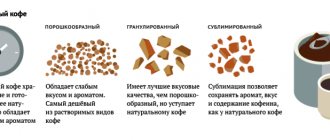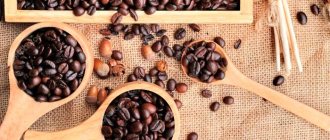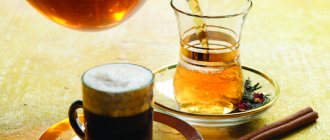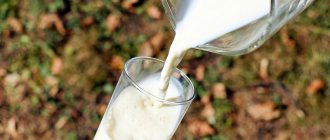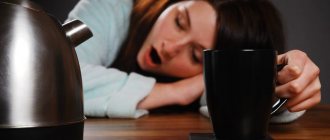Effect of caffeine on the human body
Probably everyone knows that caffeine speeds up the heartbeat and dilates blood vessels. But not many people know that there is a complex effect on metabolism. When you drink a drink that contains caffeine, the amount of adrenaline in your body increases, and this directly affects your mental state and metabolism.
Scientists say that fifty milligrams of caffeine will improve mood and increase productivity, but two hundred or three hundred milligrams will lead to heartbeat disturbances and mild tachycardia.
Consuming four hundred to five hundred milligrams can provoke depression. If you decide to drink a liter of caffeine, death will occur.
But how do you know how much caffeine is in your cup?
Table of caffeine content in coffee drinks
It is important to understand that the amount of caffeine ultimately depends on the starting raw material, brewing method and time. The quantity is also affected by the portion. For example, espresso has a serving of thirty milligrams, which means forty to seventy-five milligrams of caffeine.
It is a misconception that tea does not contain as much caffeine as coffee. For example, a small cup of instant coffee will have less caffeine than a large cup of strongly brewed tea. By the way, caffeine is also found in carbonated drinks.
Caffeine Content Table
| Drink, ml | Amount of caffeine (approximately, mg) |
| Natural coffee, 250 | 100-200 |
| Instant coffee, 100 | 30-50 |
| Decaffeinated coffee, 250 | 2-30 |
| Espresso, 30 | 40-75 |
| Black tea, 100 | 40-50 |
| Green tea, 100 | 20-30 |
| Energy, 250 | 70-100 |
| Drink with gases, 330 | 20-40 |
| Iced tea in bottles, 330 | 5-40 |
| Hot chocolate drink, 240 | 5-10 |
| Chocolate ice cream | 30-45 |
| Dark chocolate, 100 g | 30-50 |
Alkaloid in tea: what the indicators depend on
Just like in coffee, contrary to popular belief that it is almost completely harmless, caffeine is also present in tea. Its level is influenced by several factors:
- tea leaf quality;
- fermentation level;
- type of preparation;
- variety;
- concentration.
If the answer to the question of whether there is caffeine in tea is unequivocally affirmative, then the amount of it is worth arguing about. The quality of the sheet in this case is almost of key importance. Traditionally, several groups of leaves and tips (buds) are used for production.
The highest amount of caffeine is found in the top leaves. As they decrease, the proportion of caffeine also decreases. The lower shoots contain less than 1% caffeine. The price of finished tea also depends on this indicator. Expensive elite varieties are produced from the upper shoots, and cheap ones from the lower shoots. The more expensive the drink, the more caffeine it contains. At the same time, the so-called decaffeinated tea is in most cases made from the lowest shoots and still contains it in small quantities.
You might be wondering: How many calories are in a cappuccino?
The degree of fermentation, that is, the level of processing of raw materials, also plays a role. The amount of natural substances preserved in the leaves increases caffeine levels. According to this indicator, the strongest is green tea, which undergoes the least processing.
One cup of green tea contains from 50 to 70 mg of caffeine, while in its black counterpart its amount is almost halved.
The indicators provide a clear answer to the question of whether there is caffeine in green tea; moreover, they prove that green does not always mean healthier and safer.
What harm does coffee cause?
Two hundred to three hundred milligrams per day is considered a safe amount of coffee for humans. According to the caffeine content table, this is approximately three cups of espresso.
As you know, caffeine addiction exists. But it appears if you consume more than three hundred to five hundred milligrams per day. A one-time intake of half a liter of caffeine has a bad effect on the human psyche.
Scientists say that large amounts of caffeine provoke paranoia and anxiety attacks. Many people know that if you drink too much coffee, insomnia becomes your best friend.
What is caffeine?
Caffeine is a natural nervous system stimulant found in coffee, tea and cocoa beans. Currently, there is an increase in cases of caffeine overdose with many ensuing problems. Moreover, thanks to recent scientific advances, we now know that there is a gene responsible for the metabolism of caffeine. For many it is changed or absent, and therefore some should be more careful. In order for each of you to control your own caffeine consumption, we decided to tell you how much caffeine is contained in various caffeine-containing drinks and how to influence it.
Why do plants need caffeine?
To begin with, I would like to generally understand why the plant produces caffeine? Unlikely for you and me. In fact, from an evolutionary point of view, we are all selfish and any of our actions is aimed at protecting ourselves from environmental aggression factors. The coffee tree also began to produce caffeine so that it would not be harmed by various insects. There are fewer insects at higher elevations, which means there is less caffeine in such plants, and more flavonoids, terpenes and polyphenols, which are antioxidants - they account for most of the benefits of coffee.
Chemical structure of caffeine
The chemical structure of caffeine is an alkaloid. Caffeine has no odor, but only a bitter taste. The aroma of coffee comes from flavonoids, polyphenols and terpenes. Based on this, the hypothesis about the relationship between tree growth height and caffeine content is confirmed. Coffee from Ethiopia, which grows quite high, will have more acidity and less caffeine. Unlike Brazil, which will have more bitter notes and more caffeine. To keep it simple, you can use the following principle: the more bitter you taste in your cup, the more caffeine it contains. For example, enthusiasts conducted a study and measured the amount of caffeine in coffee from different countries:
Based on the results of the study, we can conclude that Starbucks sells some of the most caffeinated drinks in the world (we'll talk more about this at the end, so keep reading).
What determines the caffeine content?
1. Coffee type
The two most famous varieties of the coffee tree are Coffea arabica and Coffea canephora, better known as Arabica and Robusta. They differ greatly in taste and chemical composition. Arabica contains average amounts of caffeine, amino acids and chlorogenic acid (the main coffee antioxidant), and also has 60% more oils than robusta, which is high in caffeine and high in chlorogenic acid.
2. Roasting
There are many questions and controversial issues here. Many people believe that the coffee bean itself, regardless of the intensity of roasting, always has the same amount of caffeine, but this is not true. According to the study, green beans have 30% more caffeine than dark roasted beans (the study was conducted on Brazilian beans). Based on this, we can conclude that caffeine is destroyed when heated. For example, we can compare the compositions of starbucks light roast coffee (360 mg of caffeine in 473 ml) and dark roast (260 mg in 473 ml).
3. Number of grains
It is necessary to take into account that during roasting the coffee bean inflates (due to the release of CO2) and loses moisture, accordingly its weight decreases, and the concentration of various substances and volume increase. To make it clearer, imagine 2 glasses. Place 50g of dark grain in glass A, and 50g of light grain in glass B. So there will be more grains in quantity in glass A (with dark grains), despite the fact that the weight is the same. Thus, it may turn out that in the end there will be more caffeine in coffee made from dark roast beans, since more beans were used in quantity.
4. Temperature
Cold water is worse at extracting organic acids and other substances, including caffeine. Therefore, cold brew contains approximately 30% less caffeine than filter coffee.
5. Grinding
The finer the grind, the greater the contact area between the coffee particle and water, and, accordingly, the extraction of all substances, including caffeine, is greater.
An American study measured how three grind types (fine, medium and coarse) and different brewing methods affected the chemical composition of coffee. As a result, it was revealed that filter coffee became the leader in one serving of the drink in terms of antioxidant activity and polyphenol content in coffee, followed by espresso and cezve/Turkish coffee. The caffeine content was 316.112 and 64 mg in filter coffee, cezve/turk coffee and espresso coffee, respectively.
6. Amount of water
Water is a universal solvent. The more water, the more caffeine we will extract from the grain. This information was also proven by an Italian study, which also found that espresso has the lowest pH (meaning higher acidity) - 5.41, then cezve/turk coffee - 5.70, and finally filter coffee - 6.09. However, it is worth considering that in this study, filter coffee was made with dark roasted beans, but usually they still use light or medium roasted beans, which means they will have higher acidity.
Knowing points 4 and 5, we can now talk about a study in which we took three 25 ml cups of espresso and measured the caffeine content. We used grind sizes 6, 6.5 and 7.0. The caffeine content was found to be 77.44, 105.83, and 98.97 mg, respectively. Based on this, we can conclude that with the finest grinding, the amount of water passing through the tablet decreases, and accordingly, the amount of caffeine decreases, even despite the maximum contact area. That is, for more caffeine in espresso, you should maintain a balance and choose a medium grind. And, if the goal is to achieve the maximum concentration of caffeine in a coffee drink, and not in espresso, then you should grind the coffee as much as possible and then pour in a sufficiently large amount of hot water.
A Practical Study of Caffeine in Beverages
In this study, the researchers prepared 25 ml espresso multiple times without changing the grind size using a Super Jolly Coffee Grinder for Grocery, Mazzer, Italy. The extraction time varied from 13.5 to 17 seconds due to the fact that the variability of the particles in the grind was different each time, and accordingly the amount of water passing through varied. Ultimately, caffeine results ranged from 80 to 130 mg. From this we can understand that each time, due to the difference in preparation, the amount of caffeine will be different.
However, there is one more important thing - the grain also contains a different amount of caffeine each time. Some curious people decided to conduct a study in which they bought the same pack of coffee from the well-known company Starbucks every day for 6 days in the same store.
Based on the fact that the results vary by almost 2 times, we can conclude that even such a large company as Starbucks cannot supply coffee with a always standard amount of caffeine. This is a very variable process, depending on many factors, and is not yet controlled by anyone.
Recommended caffeine intake in mg - how much will it be in cups?
I would also like to remind you that food and drinks are a huge factor influencing a person and coffee is no exception. Thanks to caffeine, it has a very strong stimulating effect, so it is advisable not to consume it 5-7 hours before bedtime, as disturbances may occur with sleep, which is the most important period of recovery for the body. The European Food Safety Authority (EFSA) believes that consuming caffeine up to 400 mg per day does not pose any danger to an adult (excluding pregnant women and the elderly), therefore, recalculating this dose into more understandable cups, we find that you can drink one cup per day filter coffee (~316 mg of caffeine), three cups of cezve/turk coffee (~336 mg of caffeine) and as many as five cups of espresso (~320 mg of caffeine).
As a bonus, we decided to tell you an interesting fact. Starbucks sells coffee with more caffeine than its competitors. It is not clear how and why they do this, but it is a fact. Even their decaf line contains 25 mg of caffeine, and the usual one reaches up to 360 mg, despite the fact that on average everyone has about 300 mg maximum.
Coffee with the highest caffeine content in the world
While researching the topic of this article, we discovered that there are brands in the world that sell coffee with extreme caffeine content, which can reach up to 1555 mg per 354 ml, which, according to the most loyal recommendations, is at least 4 times the daily requirement. And what’s most interesting is that many of these beans are Arabica, and not Robusta, as many might think.
At the end of this article, I would like to say that coffee is a rather complex drink, which, in addition to caffeine, contains a whole storehouse of other useful and potentially dangerous substances. The scientific and medical communities have not yet formulated any clear position regarding the use of coffee, but everyone is absolutely sure that filtered coffee is the safest, since the filter itself traps many harmful substances. At the same time, when passing coffee through a filter, it is still worth remembering that moderation is important in everything and you should not consume more than 400 mg of caffeine per day.
And we will talk about exactly what harmful substances the filter retains and, in principle, what else is contained in coffee, besides caffeine, in the following posts.
Elements of the works of illustrator Peter Slattery were used in the design of the article.
Advantages and Disadvantages of Quitting Caffeine
Caffeine is only effective if you consume it only occasionally. But if you are a daily coffee drinker, you will start to feel uncomfortable when you give it up.
Headache, decreased activity, insomnia are the consequences of abrupt caffeine withdrawal. Usually such symptoms disappear after three to four days.
Conclusion
The amount of caffeine depends on the quality of the product and the brewing method. As you can see from the caffeine content table, instant coffee generally does not contain much more caffeine than black tea. When taking energy drinks, the effect of caffeine becomes more pronounced.

